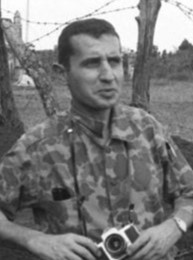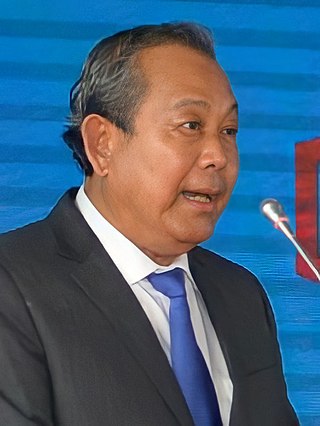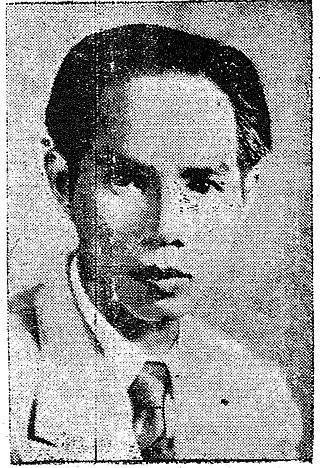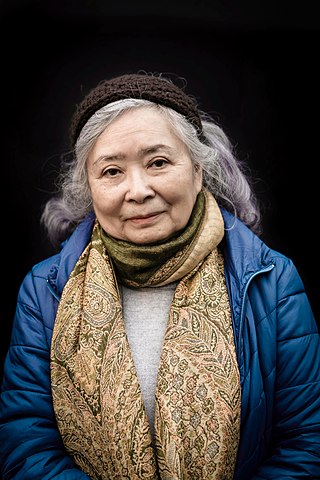Related Research Articles

Bảo Đại, born Nguyễn Phúc (Phước) Vĩnh Thụy, was the 13th and final emperor of the Nguyễn dynasty, the last ruling dynasty of Vietnam. From 1926 to 1945, he was emperor of Annam and de jure monarch of Tonkin, which were then protectorates in French Indochina, covering the present-day central and northern Vietnam. Bảo Đại ascended the throne in 1932.

Hồ Chí Minh, colloquially known as Uncle Ho or just Uncle, and by other aliases and sobriquets, was a Vietnamese communist revolutionary, nationalist, and politician. He served as prime minister of the Democratic Republic of Vietnam from 1945 to 1955 and as president from 1945 until his death in 1969. Ideologically a Marxist–Leninist, he was the Chairman and First Secretary of the Workers' Party of Vietnam, the predecessor of the current Communist Party of Vietnam.

The history of Vietnam can be traced back to around 20,000 years ago. The first modern humans to arrive and settle in the area of modern-day Vietnam are known as the Hoabinhians, who can be traced as the ancestors of modern-day Negritos. Archaeological findings from 1965, which are still under research, show the remains of two hominins closely related to the Sinanthropus, dating as far back as the Middle Pleistocene era, roughly half a million years ago.

The First Indochina War was fought between France and Việt Minh, and their respective allies, from 19 December 1946 until 20 July 1954. Việt Minh was led by Võ Nguyên Giáp and Hồ Chí Minh. Most of the fighting took place in Tonkin in Northern Vietnam, although the conflict engulfed the entire country and also extended into the neighboring French Indochina protectorates of Laos and Cambodia.

Trường Chinh, born Đặng Xuân Khu; 9 February 1907 – 30 September 1988) was a Vietnamese communist political leader, revolutionary and theoretician. He was one of the key figures of Vietnamese politics and the important Vietnamese leaders for over 40 years. He played a major role in the anti-French colonialism movement and finally after decades of protracted war in Vietnam, the Vietnamese defeated the colonial power. He was the think-tank of the Communist Party who determined the direction of the communist movement, particularly in the anti-French colonialism movement. After the declaration of independence in September 1945, Trường Chinh played an important role in shaping the politics of the Democratic Republic of Vietnam (DRV) and creating the socialist structure of the new Vietnam.

Madame Nguyễn Thị Định was the first female general of the Vietnam People's Army during the Vietnam War and the first female Vice President of Vietnam. Her role in the war was as National Liberation Front deputy commander, and was described as "the most important Southern woman revolutionary in the war". Furthermore, she was commander of an all-female force known as the Long-Haired Army, which engaged in espionage and combat against ARVN and US Forces.

Theatre of Vietnam comprises many traditional forms of drama which survive and retain their popularity to varying degrees. It formed during the Đinh dynasty, when the Đại Cồ Việt state was born. Water puppetry is a distinctively Vietnamese art form which arose in the 12th century in which a split-bamboo screen obscures puppeteers, who stand in water manipulating the puppets in front of the screen using long poles. Water puppetry is currently popular with tourists to Vietnam. With the success of the August Revolution in 1945, theatrical art entered a new creative period including a new type of theater based on the music of local folk tunes.

François Sully (1927–1971) was a French journalist and photographer best known for his work during the Vietnam War. Sully was one of the earliest journalists to cover the Vietnam War and spent 24 years in Indochina. At the time of his death in a command helicopter crash near the Cambodian border, he was viewed as the dean of the Saigon press corps.

North Vietnam, officially the Democratic Republic of Vietnam, was a socialist state in Southeast Asia that existed from 1945 to 1976, with formal sovereignty being fully recognized in 1954. A member of the Eastern Bloc, it opposed the French-supported State of Vietnam and later the Western-allied Republic of Vietnam. The DRV emerged victorious over South Vietnam in 1975 and ceased to exist the following year when it unified with the south to become the current Socialist Republic of Vietnam.

Women in the French Resistance played an important role in the context of resistance against occupying German forces during World War II. Women represented 15 to 20% of the total number of French Resistance fighters within the country. Women also represented 15% of political deportations to Nazi concentration camps.

The Blood of Others is a 1984 drama film directed by Claude Chabrol. It is based on the 1945 novel The Blood of Others by Simone de Beauvoir. The film was originally made as a three-hour English-language television film which debuted on August 25, 1984 on HBO. The film was then edited down by 40 minutes and dubbed into French for a European theatrical release.

Trương Hòa Bình is a Vietnamese politician and the former First Deputy Prime Minister of The Socialist Republic of Vietnam. He is considered to be one of the more promising members' of the Vietnamese Government, having previously served as Chief Justice of the Supreme People's Court of Vietnam from 2007 to 2016.

Vũ Cao Đàm (1908-2000) was a Vietnamese painter. He was one of the alumni of Victor Tardieu's École des Beaux-Arts de l’Indochine in Hanoi in the 1930s, along with Mai Trung Thứ, Lê Phổ and woman painter Lê Thị Lựu to emigrate to France and make a career in Paris.
Magda Cârneci is a poet, essayist, and art historian born in Romania. She took a Ph.D. in art history at Ecole des Hautes Etudes en Sciences Sociales in Paris (1997) and received several international grants in literature and art history. Member of the well-known “generation of the ‘80s” in Romanian literature, of which she was one of the theoreticians, after the Revolution of December 1989 she became actively involved in the political and cultural Romanian scene of the 1990s. In the 2000s, after working as a visiting lecturer at the National Institute of Oriental Languages and Civilizations (INALCO) in Paris, she was the director of the Romanian Cultural Institute in Paris. At present, she is visiting professor at the National University of Arts in Bucharest, editor-in-chief of ARTA magazine for visual arts, and president of PEN Club Romania. She is also a member of the European Cultural Parliament.

Madeleine Monette is a Canadian novelist, short story writer, and poet from Quebec.

Phan Văn Hùm was a Vietnamese journalist, philosopher and revolutionary in French colonial Cochinchina who, from 1930, participated in the Trotskyist left opposition to the Communist Party of Nguyen Ai Quoc.
Võ Văn Ái was a Vietnamese poet, journalist, and human-rights activist. He is an expert in the history of Buddhism and of Vietnam. He was a Buddhist and had lived in Paris since the 1950s.

Tran To Nga is a Franco-Vietnamese environmental activist. During the Vietnam War, she was a journalist, then a liaison officer for the National Liberation Front. After the war, she became a school principal before running a travel agency.
Điềm Phùng Thị was a Vietnamese modernist sculptor, considered "one of the masters of Vietnamese modern art."
References
- ↑ (ed.), Nicole Thatcher & Ethel Tolansky (2006). Six authors in captivity literary responses to the occupation of France during World War II. Oxford: Lang. ISBN 978-3039105205.
{{cite book}}:|last=has generic name (help) - ↑ Jon Henley (2004-08-21). "'You can't know how wonderful it was to finally battle in the daylight' | World news". The Guardian. London. Retrieved 2013-04-29.
- ↑ "'I put two bullets in German officer's head' recalls French Resistance heroine". France 24. 2019-08-14. Retrieved 2024-08-23.
- ↑ "Vietnamese diplomat visits French celebrity". Look At Vietnam. 2008-11-05. Retrieved 2013-04-29.
- ↑ "French heroine: I will fight for Vietnam till the last breath — TalkVietnam". Talkvietnam.com. 2011-09-02. Retrieved 2013-04-29.
- ↑ "Một bài thơ, một mối tình Việt – Pháp".
- ↑ "Vietnam Embassy - Veteran French journalist honoured". Vietnamembassy-bulgaria.org. Retrieved 2013-04-29.
- ↑ Vietnam+ (VietnamPlus) (2024-08-23). "Vietnam honors peace advocate Madeleine Riffaud". Vietnam+ (VietnamPlus). Retrieved 2024-08-23.